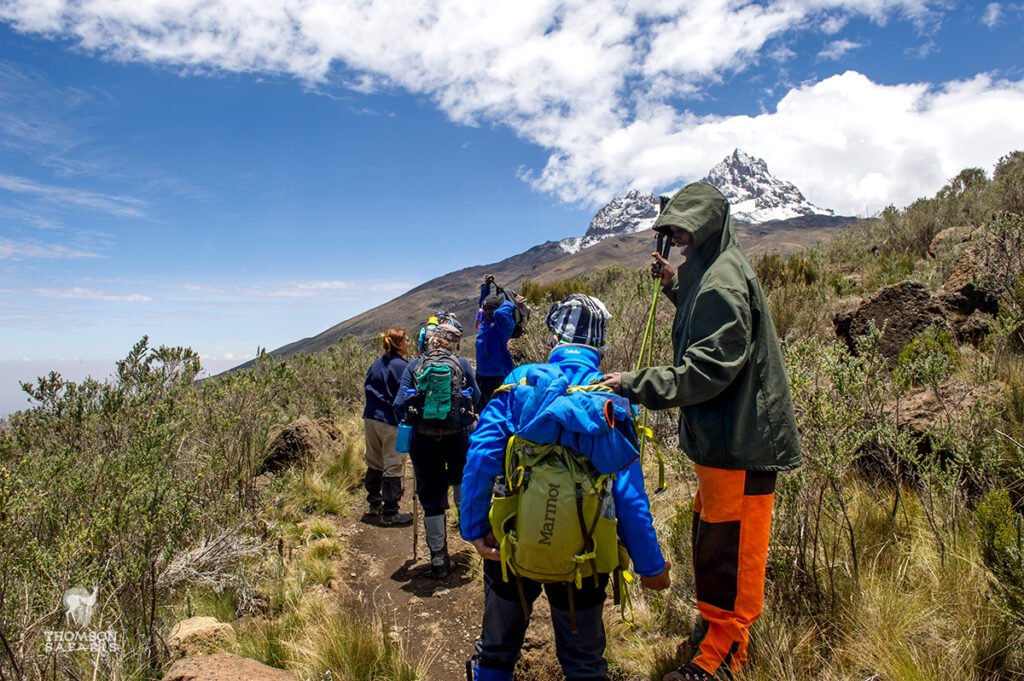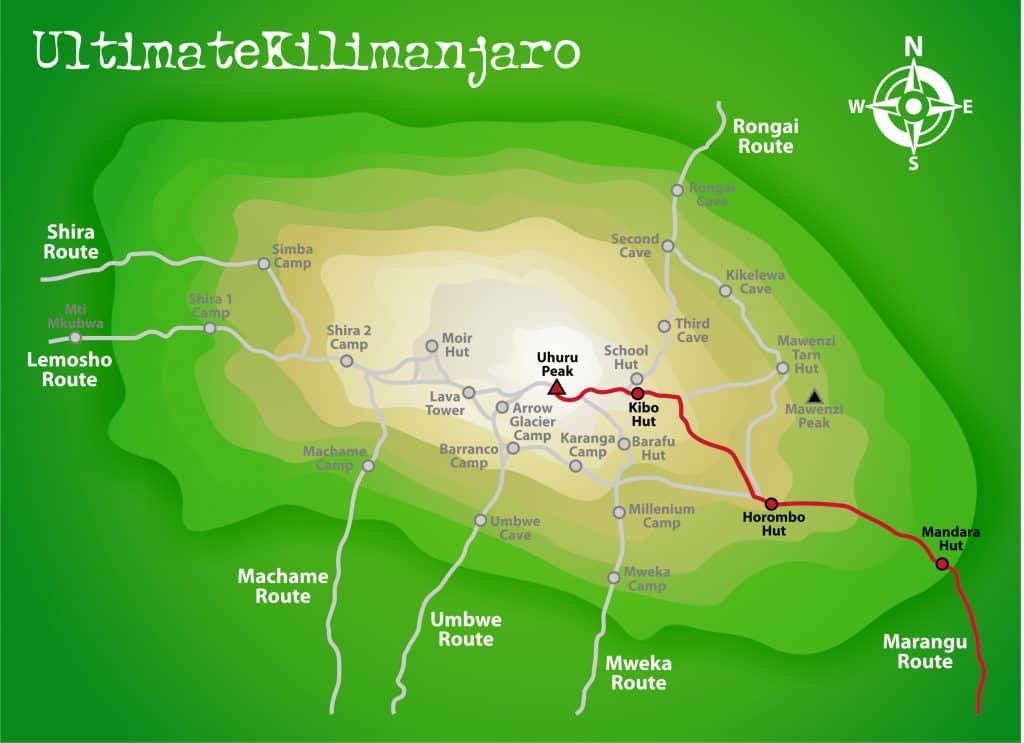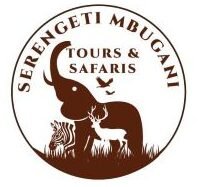5 Days Mount Kilimanjaro Marangu Route


Route Description
The Marangu route, also known as the “Coca-Cola” route, is the oldest, most well established route on Kilimanjaro. This is the only route which offers sleeping huts in dormitory style accommodations in lieu of camping. There are 60 bunk beds each at Mandara and Kibo Huts, and 120 bunk beds at Horombo Hut. Guests are supplied with mattresses and pillows, but sleeping bags are still required. The huts have communal dining halls and basic washrooms, ranging from flushing toilets and running water at the lower huts to long drop toilets and buckets of water at Kibo Hut.
Many favor Marangu because it is considered to be the easiest path on the mountain, given its gradual slope and direct path. However the short time frame of the route makes altitude acclimatization fairly difficult. The route approaches Mount Kilimanjaro from the southeast. Marangu is unfortunately less scenic than the other routes because the ascent and descent are along the same path. It is also the most crowded route for that reason.
Ultimate Kilimanjaro offers Marangu as five or six day private climb. The five day variation does not have an acclimatization day on day three at Horombo Hut.
Day By Day Itinerary
The drive from Moshi to the Mount Kilimanjaro National Park Gate (Marangu) takes about 60 minutes. And the drive from Arusha to Mount Kilimanjaro National Park gate takes about 2 hours. The journey passes through the village of Marangu which is located on the lower slopes of the mountain.
Marangu Gate to Mandara Huts
Distance: 8.3km (8.75km if taking the Nature Trail Loop); Altitude Gained: 818m
Our trek begins at Marangu Gate (1905m), the home of the park authorities and the busiest gate on the mountain. We put particular emphasis on being as early as possible at the gates, for many reasons. For one thing, it means we don’t waste time queuing up to register but can be processed immediately – which means we can get trekking soon! This first day takes us deep into the jungle bearding Kilimanjaro’s lower slopes. Being one of the first on the trail means we have the path ‘to ourselves’, enabling us to appreciate the mountain more and increase our chance of spotting wildlife on this first day before they are frightened off by the noise of other groups. So we’ll be keeping an eye out for the beautiful colobus monkeys as well as blue monkeys, as well as some of the flowers for which Kilimanjaro is famed, and in which the Marangu Route excels, such as the vivid red Impatiens kilimanjarii and Gladiolus Wastonides.
Having taken lunch in a small clearing known as Kisambioni, we continue up the slopes past small waterfalls alongside a babbling stream, to the Mandara Huts, our accommodation for the first night. Another advantage of setting off early on this first day is that you can choose the best spots in the dormitory before the other trekkers arrive, and you can be sitting enjoying the popcorn served by your crew whilst other trekkers are still struggling up the slopes. Those with the energy can join me for a brief stroll to the Maundi Crater, home to some of the lesser-known flowers on Kilimanjaro, and a place that offers stunning views east towards Mombasa and the Indian Ocean. Or you can simply sit, relax and reflect on the first day while your crew, as they will on every day of the trek, cook your evening meal.
Distance: 12.5km; Altitude Gained: 998m
Today is an important one in your Kilimanjaro trek: a day when you not only climb above the tree line and leave the forest behind, but also catch your first sight of both the Mawenzi summit, Kilimanjaro’s second summit, but also its snow-covered bigger brother, Kibo – your ultimate destination! Today is also the day that we start to pace ourselves, taking each step slowly, to help us acclimatize to the increasingly rarified air. We are now in the heath and moorland zone, Kilimanjaro’s second vegetation zone, with such unusual plants as the giant groundsel and Lobelia deckenii decorating the path. Our destination on this second day is the Horombo Huts (3721m), a chilly but welcoming set of A-Frame huts offering glimpses of Kibo to the west. Popcorn and a hot drink will be served to you upon arrival, followed by dinner in the evening.
Distance: 9.5km (10.3km on the Mawenzi Alternative); Altitude Gained: 993m
If we have opted for a six-day climb, the third day will be a ‘rest day’ – though that doesn’t mean we actually rest! Instead, today’s walk takes us up the southern slopes of Mawenzi, to get some of the best views of Kibo to be had anywhere, as well as a gorgeous panorama overlooking the wild and inhospitable desert of the Saddle. We also visit places such as the strange Zebra Rocks – rocks streaked over the centuries by water until they resemble the flanks of a zebra.
- This day is not just about sightseeing, however, for the rest day serves a more important purpose than that helping your body to acclimatize fully, to make the rest of the trek easier – and hopefully help you to reach the summit too!
For those who are continuing straight to Kibo, the scenery once again changes today as we leave just about all vegetation behind to enter the windswept wilderness of the Saddle, the high-altitude desert separating Kilimanjaro’s twin peaks of Kibo and Mawenzi. That doesn’t mean that the day is not without interest, however, for the beauty of the desert is undeniable, the light is usually wonderfully clear, meaning that you’ll be wanting to get out your camera every few seconds to photograph Kibo; and there are enough features on the way, including some weird and wonderful parasitic craters, to take your mind off the exhaustion you may now be feeling. Our goal on this third day is the Kibo Huts, set at the foot of the summit of the same name. Attractively built in stone, and with the occasional mountain buzzard soaring overhead for company, you’ll spend the rest of the day sleeping and eating in preparation for the night ahead.
Distance: 6.25km to Uhuru Peak; plus 15.75km back to Horombo Huts (16.55km for Mawenzi Alternative) Altitude Gained/Lost: 1181m to Uhuru Peak, then 2174m descent from Uhuru to Horombo Huts
Rising at around midnight, we begin our slow march up to Gilman’s Point (5719m) on the edge of the Kibo crater, past such features as Hans Meyer Cave (5259m). It’s a steep, slow, cold march and a test of your endurance – this is where you’ll earn your Kilimanjaro certificate. Nevertheless, providing you have avoided altitude sickness and have acclimatized well, there is no reason why you shouldn’t make it up to Gillman’s. This we reach, all being well, at around 5 am, though it can be much later depending on both your condition and the conditions on the mountain. Our work is not yet over, however, for it’s around another hour and a half to Uhuru Peak. The gradient on this last section, especially by the standards of this night, is relatively flat – but at this altitude, every step can be exhausting. It is also a glorious walk, however, with glaciers and snowfields on one side and with views over the Kibo Crater on the other. At the end of the trail lies our ultimate destination, Uhuru Peak, the highest point in Africa! Here, if we’re on time, we can watch the sunrise over the African continent, take photos – and take a breather too! After a rest at the top, we continue back down to Kibo Huts – a walk that is considerably quicker than it was on the way up! At Kibo, we take breakfast and relax for an hour or so, before continuing our march down the mountain, through the Saddle, heath and moorland zones before stopping, finally, at the Horombo Huts once more. We should arrive there at about 4 pm – and you have been walking for around 16 hours, fewer breaks! Exhausting but, if you made it to the top, you’ll think it was worth it!
Distance: 20km (20.75km on the Nature Trail) Altitude Gained/Lost: 1816m And so we come to the last day of our trek, as we march back through the forest to Marangu Gate, smiling smugly at all those coming up the slope the other way. Stopping at the Mandara Huts for lunch, we continue heading down until we once more reach Marangu Gate, where those who conquered the mountain – or at least made it to Gillman’s Point – collect their certificates. A jeep will be waiting to take everyone back to their hotel – and the land of cold beers and warm showers.
Inclusions
- Services of a professional & well experienced English speaking safari driver guide
- All park fees & game drives as per itinerary
- All meals: Breakfast, Lunch & Dinner during the safari
- Government value added tax (VAT)
Exclusions
- Transport based on an excellent 4×4-wd vehicle
- Accommodations
- Service of an English-speaking driver-guide
- Breakfasts, lunches, dinners, fruit, and a cup of coffee
- Complimentary bottle of water daily
- Airport transfers
- All government taxes and VAT inside the park
- Government park fees, car entrances fees, and taxes on park fees for nonresidents
- First-aid supplies
- Rescue fees

